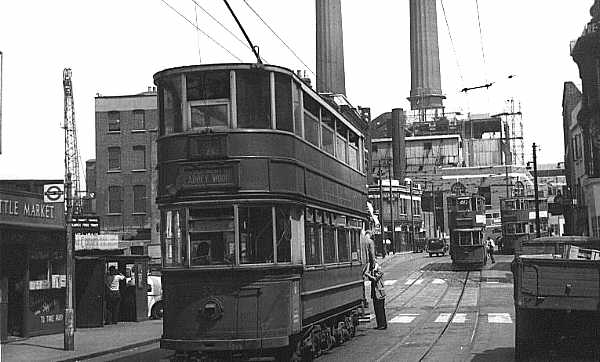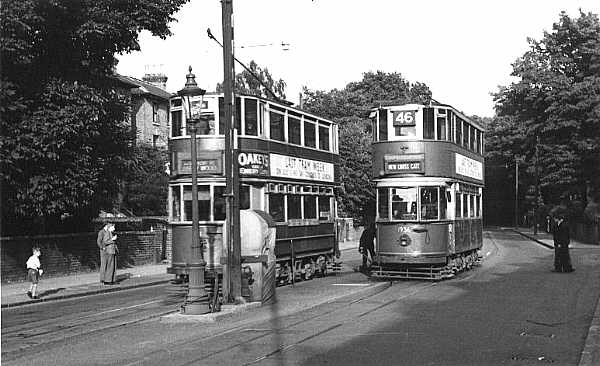

| View of Woolwich High Street. Tram services 36, 38 and 40 use the changeover point in Market Hill just up ahead. The Abbey Wood bound tram in the foreground has just had its trolley pole raised by the conductor to the overhead. It will move off and "shoot its plough" into the change pit ahead. On London bound trams the plough has to be put back in manually by the pit attendant and the pole is then lowered and hooked down. Note the overhead in the picture is for trollybuses which terminated at Parsons Hill a few yards further along the road. Also note the conduit groove in the centre of the tram lines for picking up the current. The power station in the picture still has only two chimneys instead of three. It was demolished circa. 1980. The turning on the left is Woolwich Ferry Approach, now moved back along the road opposite what was then Parsons Hill, now, John Wilson Street. The whole of the left hand side of this part of the road is The WaterFront Leisure Complex. |

| A similar view at Lee High Road, Lee Green, looking very leafy in this view looking towards Eltham. In the other direction you would see the Lee Green cross roads and the fire station. Eltham bound trams would have stopped at the cross roads to have the conductor put up the trolley to pick up power from the overhead, then move off to expel the plough into the pit. There was no power to the plough at this point, so there was no danger of electrocution. As at Woolwich London bound trams would slow to walking pace as the plough was forked in by one of the attendants. It would then stop for the conductor to lower the trolley pole, before making its way to London under power from the conduit. |
| Building conduit tramways was an expensive option. For this reason
the more suburban areas were on the overhead wire arrangement. This is
why there were change over points.
A huge exhibition for the Festival of Britain was to be held on London's South Bank in 1951. This necessitated revamping the transport facilities in the area around the Waterloo area. This included the tramway system, which when the work was carried out in 1950 only had another two years to run. To find out more about what was involved in laying this new conduit tramway follow this link. to Dewi's Williams facinating pages. |
| There was a disscussion on the Eurotrams group recently about the location
of the conduit change over points in London with several people making
contributions. Does anybody know if there is any evidence still in existance
at any of these sites?
The list currently reads: 1 Wandsworth Putney Bridge Road, near West Hill & High Street
|
This page was designed and is maintained
by Toby and John King, I would accept any comments or questions See
Index Page